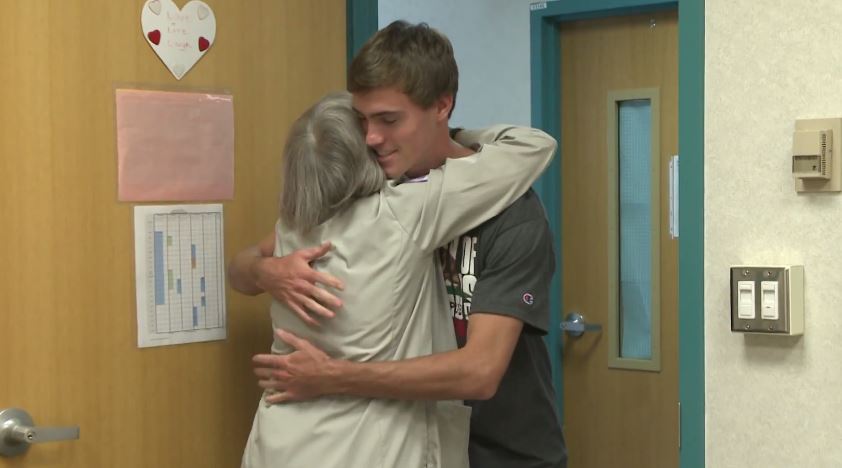Why can’t I read?

Tom Condon has a lot going for him; he has the looks of an actor with the personality and smile to match. But his character and discipline is what defines his life. His perseverance is partially due to being diagnosed with dyslexia at a young age.
For Tom, getting through elementary and high school required a lot of extra discipline. It definitely wasn’t easy. But for him, that commitment to finding ways to learn despite his dyslexia has prepared him for both college and for life. “I don’t look at dyslexia in a negative way,” he says. “I believe I got it for some reason.”
As a little boy, many of the classes Tom needed to pass in order to achieve his dreams created fear, confusion and anxiety for him. “I literally had tears running down my face,” says Tom. He would ask himself, “Why do I have to be like this?” And while his friends were learning spelling and math, he was still struggling with reading.
It was just before starting elementary school that Tom and his family learned why he was struggling. It was dyslexia, a condition that occurs in children with normal vision and intelligence but who often can’t grasp the basics of reading. Understanding the reason behind Tom’s frustration was an essential first step. Once they knew why he was struggling, his parents started looking for solutions.
Dyslexia is a learning disability that makes reading very difficult; most kids are ready to learn to read by kindergarten or first grade, but that isn’t the case for children with dyslexia. Recognizing Tom’s symptoms and diagnosing him with dyslexia when he was very young was essential. With that diagnosis came an understanding that Tom needed to learn in a different way. Tom would have to find ways to work around the challenges of dyslexia. And that required a commitment from his entire family to provide him with support, both intellectual and emotional.
“Dyslexia is an issue about acquiring the ability to read. Children with dyslexia lack the ability to decode,” says Advocate Children’s Hospital physician Dr. Frank Belmonte. “They are born with the condition, but it might not become obvious until they reach the age range where they are expected to begin acquiring reading skills. Kids like Tom are born with a neuro development condition that involves a structural issue with the brain. Although you can’t change the brain’s structure, you can learn ways to work around the disorder.”
Tom and his family teamed up with Dr. Marjorie Getz, a learning behavioral specialist at Advocate Children’s Hospital Developmental Pediatrics. Dr. Getz says the main thing for children like Tom is changing the way they are taught to help their brains understand. “We teach them the rules of reading in a very systematic way,” says Dr. Getz. “Treatment focuses on modified teaching methods like repetition with intensity.”
Dr. Getz points out that kids with dyslexia are impacted by dyslexia in two main ways:
- Challenge with word recognition; decoding words
- Reading fluency
“The help comes to these students by teaching them to learn in a different way. The instruction is multi-sensory, engaging many senses,” says Dr. Getz. “We have them read the print. We have them hear the words in print. We have them write the words. We might even have them write the words in the sand or with shaving cream…so they can feel it.” Repetition with intensity is key. Instruction in the morning. Bring back for another dose in the afternoon. Send that work home with the parents at night. This approach works with these kids.
According to Tom’s mom, Khristine, once Tom began to learn in this new way, things got a lot better. His comprehension skyrocketed. His ability to read skyrocketed. His confidence in his ability to learn skyrocketed.
“My mind actually gets lost and it comes out different from what I see. I’ll see the word ‘the’ but I might say the word ‘is’ or something like that. I had to train my mind to slow down.”
“These students are often very intelligent,” says Dr. Belmonte. “They just need a little bit of help to unleash their potential.”
All that work Tom has put into his future has really paid off, as he is now heading off to college. It’s been a tough and disciplined battle but one well worth the effort. Tom says the support of his family has been essential. “My mom is amazing.”
Tom’s mom says, with tear in her eyes, “We’re very proud. He has a disability, but the disability doesn’t define who he is. It feels good. There were many years of battle. The fact that he has gotten to the stage where he appreciates all the effort he put into it feels good.”
Tom’s advice for others with dyslexia? “Keep pushing. It is 100 percent worth it in the end. You’ll get there!”

Related Posts
Comments
About the Author

health enews staff is a group of experienced writers from our Advocate Health Care and Aurora Health Care sites, which also includes freelance or intern writers.
















